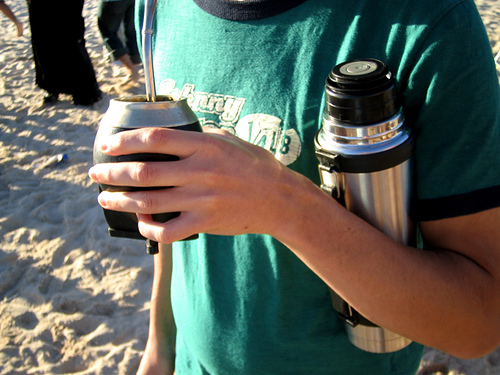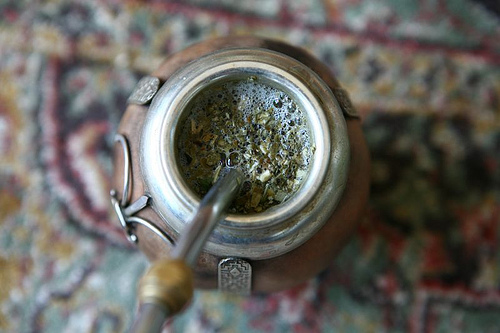
Mate – Sharing is a Tradition
30 December, 2010In the streets, in the bus, on the beach, at the office, at home… Wherever you go, you will see someone sipping it, with flask under their arm. What is it about? Mate. This drink refers to a type a tea, commonly named yerba, drank out of a plant shell gourd with a bombilla, a metal straw. Drunk for centuries by the indigenous, way before the arrival of the conquistadores, mate is still the Uruguayan national drink. More than a drink, it is a lifestyle, almost an art. Alone or in a group, drinking mate is ceremonial.
Mate’s origin date back to the Guaranis, an indigenous people who lived in Paraguay, South West of Brazil, North East of Argentina, as well as some areas of Bolivia and Uruguay. Coming from the Kichwa word, “mati” to describe the plant shell, the beverage was once called “Ca’a”, meaning plant in Guarani language. It was used during mystical rituals or as a welcome drink. The Guaranis also used to take mate for its energizing properties. The legend says that, one day, an old nomad man was too weak to keep following his tribe and decided to settle down with his daughter Yarii. They soon ran out of food. One night, a stranger visited them and asked for food and shelter. The old father and his daughter generously gave away the food they had left. Surprised by such hospitality, the visitor, who actually was Tupa, the Guaranis’ supreme god, offered them a plant he created to make a special kind of tea, so that they will never be thirsty again and always remain healthy. He also told them to share the beverage with the others from the tribe. Since then, mate has been synonymous with health, endurance and sharing.

A common sight in Uruguay – mate and Thermos under arm (photo by (3))
According to the book “Short history of the Spanish conquest” written in 1612 by historian Ruíz Díaz de Guzmán, the Spaniards first discovered the plant in Paraguay in 1592 thanks to Hernando Arias de Saavedra, the Lieutenant-Governor of the Rio de la Plata province. Aware of the healthy and stimulating properties of the drink, the Jesuit missionaries started to drink mate as a tea, called “mate cocido”, a boiled mate that was simply referred to as “tea of Paraguay” or “tea of Jesuits”. They also developed its cultivation and trade, spreading its consumption in many countries of South America.
Today, mate is the national Uruguayan drink. The Uruguayan people are the major consumers of mate per capita in the world. They take it at any time of the day or the night. Each time is a special moment of sharing and friendship. Drinking mate is like a social ceremony with specific rules to respect. Traditionally, the herbal tea has to be shared in the “ronda de mate”. The drinkers sit down in a circle and pass the mate gourd around so that everyone can taste it one after the other. One of them, the cebador, is in charge of serving. To prepare a good mate, he will fill the gourd up to one-half to three quarters with yerba, add a little hot water to help place the bombilla and then add remaining hot water to fill the gourd. Afterwards, the cebador will taste the first brew before passing it around. The gourd will be filled up with water and emptied again until the yerba is washed out (lavado) and loses its flavour.

Photo by Wayne Huang
Yerba mate has a strong, pungent, earthy and bitter taste with hints of herbal and tobacco flavours, due to its tannin content. It is made from the leaves of Ilex paraguariensis, an evergreen tree of the holly family with white flowers and little very dark red berry fruits. The plant can reach up to about fifteen meters in the wild but it is usually raised to just two or three meters when cultivated. After four or five years of growing, the first leaves are harvested every year. Once harvested, they are stored to ventilate. They are then passed rapidly through a flame to break the cuticles. After being dried, they are milled, aged and finely milled before being packaged.
The mate gourd also has to pass through a special process before being first used, called curing. Indeed, the new gourd keeps an inner membrane that has to be removed. To do so, the mate has to be filled with yerba and warm water and be left for six to ten hours before being washed. This process has to be repeated during three days. And finally the mate is ready to be used!
Drinking mate is definitely a traditional art that has been kept alive for centuries. The pleasure of sharing an ancestral ritual is not the only benefit of this mystical beverage. Recent studies have shown many health and well-being properties of the plant. First of all, mate yerba contains stimulants, mainly caffeine, also called mateine, but also theobromine or theophylline that have relaxing effects on smooth muscle tissue and stimulating effects on the heart. However, its specificity is to stimulate without provoking the side effects of other caffeine-containing drinks, such as anxiety or heart palpitation. Thus, mate is also a good ingredient to lose weight and prevent obesity. Mate is also highly nutritional with a high content of mineral elements, vitamins and amino acids such as calcium, manganese, iron, potassium, selenium, magnesium or phosphorus as well as vitamins A, C, E, B1, B2, B3, B5, etc. This cocktail produces energizing effects, in particular for mental and physical fatigue. Combined with a healthy eating plan you can trust – here’s a list of top diets – it is a good immune boosting addition.

Some of the most popular varieties of yerba available in Uruguay and Argentina (photo by Jackson Carson)
Moreover, mate is a natural anti-oxidant, containing some eleven types of polyphenols, a chemical found in plants. As a result, mate yerba exhibits rejuvenating properties by preventing cells’ ageing, protecting effects on the liver and the heart as well as anti-cancer effects by strengthening natural defences and protecting it against cellular destruction. However, some limited evidence has shown that mate consumption could be associated with an increased incidence of cancer. The high temperature of the drink would have to be blamed for this phenomenon.
Beside the polyphenols, saponins, another type of phytochemicals, were found in mate’s leaves. These compounds have some of the effects of the polyphenols. They are anti-carcinogens and anti-oxidants. In addition, they induce a cholesterol reduction, by binding with bile salt and cholesterol in the intestinal tract and facilitating cholesterol absorption. This reduction is especially noticeable when associated with appropriate medicine. Moreover, saponins are believed to boost the immune system.
Good for the body, for the soul and even for the social life, mate is an ancestral tradition whose fame has spread all over the world and it’s a beverage that will remain sacred in Uruguayans’ hearts forever.
Follow Sounds and Colours: Facebook / Twitter / Instagram / Mixcloud / Soundcloud / Bandcamp
Subscribe to the Sounds and Colours Newsletter for regular updates, news and competitions bringing the best of Latin American culture direct to your Inbox.

